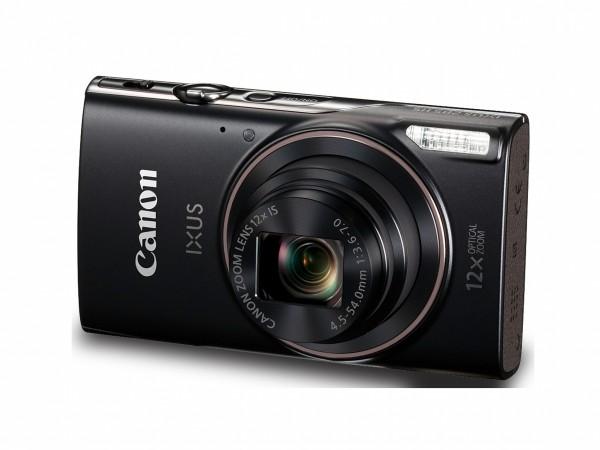
Canon, famed for their EOS series of DSLRs, have two more product lines under which they make small sensor-cameras. One line is the PowerShot series, and the other is the IXUS, aimed at the kind of people for whom photography is about memories. The cameras are compact, require very little user input and include several features that make photography a breeze. It is one such camera we are reviewing â€" the Canon IXUS 285 HS.
Overview
The 285 HS is a tiny camera, small enough to hide away in someone's bag and light enough for one to easily forget that it's even there. It is, however, a little on the thicker side, measuring almost an inch in thickness. If you're the type to wear skinny jeans or slim-fit chinos, this camera doesn't quite feel at home in the pocket. The camera features a 1/ 2.3" sensor which clicks images at 20MP resolution, which is processed by a DIGIC 4+ processor â€" the same one found in Canon's new DSLR, the EOS 1300D.
The lens offers 12x magnification, zooming all the way from 4.5mm to 54mm. If you're a photo nerd, you'd be blow away when we say it offers a 35mm focal-length equivalent of 25 to 300mm. If the last sentence made no sense to you, just remember to bring this baby along if you're going bird-watching; it has massive zoom, which can be further extended to 24, which essentially translates to 600mm at the tight end. So when you go bird watching, remember to take a tripod along.
The image size ranges between large (5,184 x 3,888 pixels), medium 1 (3,648 x 2,736 pixels), medium 2 (2,048 x 1,536 pixels), medium (2,592 x 1,944 pixels) and small (640 x 480 pixels). Aspect ratios include the standard 4:3 picture format as well as 16:9, 1:1 and 3:2. It also shoots video at full-HD resolution, which can be brough down to 1,280 x 720 and 640 x 480.
The camera's ISO sensitivity ranges between 80 and 3,200. It has a maximum shutter speed of 1/2,000 sec and has an image stabilising system that works by moving the lens, much like the system found in Canon's DSLR lenses. Once you've clicked your pictures, you can view them on the 3" 461K-dot LCD screen. Social media enthusiasts will rejoice in the fact that the camera offers NFC and Wi-Fi support, allowing them to upload pictures to Facebook and Instagram on the fly.
Touch and feel
The camera measures roughly 4" by 2" and, like we mentioned before, is about an inch thick. The curved front and the flat back enable it to fit neatly in the hand when you're not shooting. And as it weighs less than 150g, holding it up for extended periods doesn't make you feel uncomfortable. With all the buttons restricted only to the right of the camera, it's definitely possible to operate it with one hand, but for those with frying pans for hands like that of the author, using the camera with two hands is advised if avoiding carpal tunnel syndrome is high on the list of priorities.
Around the front is the lens, the autofocus (AF) illuminator, the mic and the flash.
Around the back is the LCD screen, which is a total fingerprint magnet, and a total of nine buttons including a dedicated video recording button.
The top features the power button, the shutter and zoom controls as well as the shooting mode selector.
The bottom is where you'll find the 1/4" universal tripod socket and the battery/memory card access door. The side to the right of the lens houses the inbuilt speaker and to the left of the lens is the AV and HDMI out.
Shooting
Shooting on the IXUS HS 285 is delight. The AF is responsive, the IS works well, the zoom is convenient and there is almost no shutter lag. The only gripe we have is the speed of the lens, by which we mean the widest aperture range. While fully zoomed out, the IXUS HS 285 has an F number of 3.6, which is about what one would find in Canon's 18-55mm DSLR kit lens, but when zoomed in, the aperture drops to F 7, which allows a lot less light in, translating to a slow shutter speed. Shooting in dimly-lit places like concerts, while fully zoomed in, does not result in good pictures. But, an easy fix we found was to raise the ISO, underexpose the picture by a stop at the least and brighten the image later.
The IXUS HS offers several shooting modes, including AUTO, Handheld Night Scene, Low Light and Fish-eye Effect, but we stuck to P mode and the creative shot mode. The P mode works much like auto, but allows users to decide whether they want the image to be overexposed or underexposed and what ISO they'd like to shoot at.
The creative shot mode, however, is a little cooler. Pressing the shutter down while in this mode captures one image on which the camera works its magic and presents five images that are artfully cropped and edited.
The next interesting feature is the high-speed burst mode. While the camera is good for about three shots on continuous shot mode, it can shoot upto 7.2 frames a second on high-speed burst mode, albeit at 5 megapixels.
Uploading the images could have been a little less complicated, but we guess that's a small price to pay if high-speed data transfer and not having to bring a laptop with you to transfer images every time you go on a trip is something you's want. The camera can be connected to smartphones, tablets, computers, Wi-Fi-enabled printers and web services.
Pairing with a smartphone or a tablet begins with an NFC authentication. If your device isn't NFC-enabled, you can connect to the camera by pressing the wireless button on the back and treating it like a Wi-Fi router. Once connected, the only way to transfer images wirelessly is via the Canon Camera Connect app, which not only allows users to view the images saved in the memory card, but also download them. Once they are saved, you're free to upload images/format the memory card and begin again.
Image Quality
We found that the IXUS 280 HS has a tendency to overexpose images just a tiny bit. Whether it was in a dark indoor concert hall or outdoors, the images, in our opinion, turned out looking better when adjusted slightly. This results in the colours appearing a little washed out, especially while shooting in the daytime, but it's quickly fixed by dialling back the exposure in the compensation setting.
The colours when, the camera does get the exposure right are vivid and pleasing.
The lens, by virtue of being relatively slow, is the main reason why you'd end up shooting at really high ISO sensitivity settings. The camera, as it is expected, shoots well at low ISOs and holds rather well up to ISO 800, but anything upwards of ISO 1600 and especially at ISO 3200 isn't really great to look at, but we do have to give it to Canon for controlling the noise levels.
The focus is fast, with the ability to track subjects, even giving priority to faces. Fully zoomed in, with the shutter half pressed, we were impressed with how well the camera was able to maintain focus on the bird (pictured above) despite the unavoidable zoom-induced shake.
The camera also has a pretty sweet macro mode. Fully zoomed in and switching the focus setting to macro yielded in basically no AF lock, but zoomed out, the camera was more than comfortable with shooting things right up to the lens' front element. Digging into the spec sheet, we found Canon saying that the minimum focusing distance is 1cm when the lens is zoomed out, which drastically drops to 1m when zoomed in. In macro mode, the focussing distance ranges between 1cm and 50cm and works only when fully zoomed out. The only sad part about the macro mode is that the image becomes soft as you move closer to the subject.
What we think
The Canon IXUS 258 HS is a delight to shoot with. It's compact and handy, and it takes almost no time to get used to the hardware. On the software front, the shooting menu can get a little fiddly, but it's still not something that really bothered us. Being really light, it's no big deal mounting this baby on a selfie stick and switching the timed shutter release to 2 seconds. Just remember to switch face detection on.
What we wish Canon could have addressed is definitely the connectivity option. That the camera needs an app to transfer files is a tad annoying. A second thing that bothered us was the wrist strap Canon had bundled with the camera. While it's definitely of use, it could have either been a tad bit longer, allowing users to loop it twice around their wrists, or at least come with something to tighten it around the wrist while shooting.
We were also a little unhappy with the battery performance, which lasted only about 260 shots, but according to Canon, the 800mAh battery only is good for about 180 shots, which goes up to 265 in Eco mode. Seeing that we didn't enable the setting that doesn't club baby seals over the head, we're not sure how to react.
Overall, we think the Canon IXUS 285 HS is a really good camera that's most at home in a bag or a purse. It's the kind of camera that accompanies you as you go about your life.









